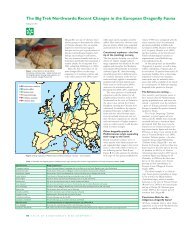download - LUPO GmbH
download - LUPO GmbH
download - LUPO GmbH
- TAGS
- download
- lupo
- lupogmbh.de
Sie wollen auch ein ePaper? Erhöhen Sie die Reichweite Ihrer Titel.
YUMPU macht aus Druck-PDFs automatisch weboptimierte ePaper, die Google liebt.
Jürgen Ott<br />
7. Literatur<br />
ASKEW, R. R. (1988): The Dragonflies of Europe. – 291<br />
S. Harley Books. Colchester.<br />
BELLMANN, H. (1987): Libellen beobachten – bestimmen.<br />
271 S., Neumann-Neudamm Verlag. Melsungen.<br />
BURBACH, K. (2000): Nachweis einer zweiten Jahresgeneration<br />
von Enallagma cyathigerum und Ischnura<br />
pumilio in Mitteleuropa (Odonata: Coenagrionidae).<br />
– Libellula 19 (3/4): 217-227. Mönchengladbach.<br />
CHAM, S. (1991): The Scarce Blue-tailed Damselfly, of<br />
Ischnura pumilio (Charpentier): its habitat preferences<br />
in south-east England. – Journal of the British<br />
Dragonfly Society 7 (1): 18-25. Granby.<br />
CHAM, S. (1992): Oviposition behaviour and observations<br />
on the eggs and prolarvae of Ischnura pumilio<br />
(Charpentier). – Journal of the British Dragonfly Society<br />
8 (2): 6-10. Granby.<br />
CHAM, S. (1993): Further observations on generation<br />
time and maturation of Ischnura pumilio with notes<br />
on the use a mark-recapture programme. – Journal<br />
of the British Dragonfly Society 9 (2): 40-46. Granby.<br />
CORDERO, A. (1990): The adaptive significance of the<br />
prolonged copulations of the damselfly, Ischnura<br />
graellsi. – Animal Behaviour 40: 43-48<br />
CORDERO RIVERA, A. & ANDRÉSABAD, J. A. (1999): Lifetime<br />
mating success, survivorship and synchronized<br />
reproduction in the damselfly Ischnura pumilio<br />
(Odonata: Coenagrionidae). – International Journal<br />
of Odonatology 2 (1): 105-114. Leiden.<br />
DIE RHEINPFALZ (2007): Nr. 301. Ausgabe vom<br />
29.12.2007. Ludwigshafen.<br />
DIE RHEINPFALZ (2008): Nr. 5. Ausgabe vom 7.1.2008.<br />
Ludwigshafen.<br />
DIJKSTRA, K.-D. (2006): Field Guide to the Dragonflies<br />
of Britain and Europe. 320 S., British Wildlife Publishing.<br />
Dorset.<br />
DU FEU, C., HOUNSOME, M. & SPENCE, I. (1983): A<br />
single-session mark/recapture method of population<br />
estimation. – Ringing and Migration 4: 211-226.<br />
Tring.<br />
EISLÖFFEL, F., NIEHUIS, M. & M. WEITZEL (1993): Rote<br />
Liste der bestandsgefährdeten Libellen (Odonata) in<br />
Rheinland-Pfalz (zweite, neu bearbeitete Fassung,<br />
Stand: Juli 1992). 28 S., Mainz.<br />
FOX, A. D. (1989): Ischnura pumilio (Charpentier)<br />
(Odonata: Coenagrionidae) – a wandering opportunist?<br />
– The Entomologist’s Record and Journal of<br />
Variation 101 (1,2): 25-26. Southampton.<br />
FOX, A. D. & CHAM, S. A. (1994): Status, habitat, use<br />
and conservation of the Scarce Blue-tailed Damselfly<br />
(Ischnura pumilio) (Odonata: Coenagrionidae)<br />
in Britain and Ireland. – Biological Conservation<br />
68: 115-122. Barking/Essex.<br />
GERKEN, B. & K. STERNBERG (1999): Die Exuvien Europäischer<br />
Libellen (Insecta: Odonata). 354 S.,<br />
Huxania Verlag. Höxter.<br />
GRAND, D. & BOUDOT, J.-P. (2006): Les Libellules de<br />
France, Belgique et Luxembourg. 480 S., Collection<br />
Parthénope. Metz.<br />
260<br />
HEIDEMANN, H. & SEIDENBUSCH, R. (1993): Die Libellenlarven<br />
Deutschlands und Frankreichs – Handbuch<br />
für Exuviensammler. 391 S., Goecke & Evers.<br />
Keltern.<br />
HUNGER, H., & SCHIEL, F.-J. (2006): Rote Liste der Libellen<br />
Baden-Württembergs und der Naturräume,<br />
Stand November 2005 (Odonata). – Libellula, Supplement<br />
7: 3-14. Wolnzach.<br />
HUNGER, H., SCHIEL, F.-J. & KUNZ, B. (2006): Verbreitung<br />
und Phänologie der Libellen Baden-Württembergs<br />
(Odonata). – Libellula, Supplement 7: 15-188.<br />
Wolnzach.<br />
INDEN-LOHMAR, C. (1997): Nachweis einer zweiten<br />
Jahresgeneration von Ischnura elegans (VanderLinden)<br />
und I. pumilio (Charpentier) in Mitteleuropa. –<br />
Libellula 16 (1/2): 1-15. Mönchengladbach.<br />
JURZITZA, G. (1970): Beobachtungen zur Oekologie<br />
und Ethologie von Ischnura pumilio (Charp.). –<br />
Beiträge zur naturkundlichen Forschung in Südwestdeutschland<br />
29 (2): 151-153. Karlsruhe.<br />
JURZITZA, G. (2000): Der Kosmos Libellenführer. 191<br />
S., Kosmos. Stuttgart.<br />
KIKILLUS, R. & WEITZEL, M. (1981): Grundlagenstudien<br />
zur Ökologie und Faunistik der Libellen des<br />
Rheinlandes. Veränderungstendenzen einer Libellenfauna<br />
in belasteten Ökosystemen. – Pollichia-<br />
Buch Nr. 2: 245 S., Bad Dürkheim.<br />
LAUER, H. & NÄGLE, W. (2005): Ein Naturschutzgebiet<br />
stirbt. Pollichia-Kurier 41 (4): 26-28. Bad Dürkheim.<br />
LANDMANN, A., LEHMANN, G., MUNGENAST, F. &<br />
SONNTAG, H. (2005): Die Libellen Tirols. 324 S. Berenkamp.<br />
MONNERATH, C. (2005): Ischnura pumilio (Charpentier,<br />
1825). S. 166-169. In: WILDERMUTH, H., GON-<br />
SETH, Y. & MAIBACH, A. (2005): Odonata. Libellen<br />
der Schweiz – Fauna Helvetica 12: 398 S., CSCF,<br />
Neuchâtel.<br />
NELSON, B. & THOMPSON, R. (2004): The National History<br />
of Ireland’s Dragonflies. 454 S., Ulster Museum.<br />
Belfast.<br />
NIEHUIS, M. (1984): Verbreitung und Vorkommen der<br />
Libellen (Insecta: Odonata) im Regierungsbezirk<br />
Rheinhessen-Pfalz. – Naturschutz und Ornithologie<br />
in Rheinland-Pfalz 3 (1): 1-203. Landau.<br />
OTT, J. (1990): Die Libellenfauna des geplanten Naturschutzgebietes<br />
"Gelterswoog-Kolbenwoog" – mit<br />
einem Wiederfund von Somatochlora arctica ZET-<br />
TERSTEDT für Rheinland-Pfalz. – Fauna und Flora<br />
in Rheinland-Pfalz 6 (1): 227-246. Landau.<br />
OTT, J. (1993a): Die Libellenfauna des Stadtgebietes<br />
von Kaiserslautern – Ergebnisse einer Stadtbiotopkartierung<br />
und planerische Konsequenzen. – Fauna<br />
und Flora in Rheinland-Pfalz 7 (1): 103-146. Landau.<br />
OTT, J. (1993b): Studie zur Umsetzung des Libellenschutzes<br />
im Rahmen der Leitbildentwicklung zur<br />
Sicherung und Entwicklung naturnaher Fließgewässerökosysteme.<br />
Unveröff. Studie. Erstellt im<br />
Auftrag des Landesamtes für Umweltschutz und<br />
Gewerbeaufsicht Rheinland-Pfalz. 59 S. inkl. Anhang.<br />
OTT, J. (2001): Zum Einsatz von Libellen als Bioindi-



